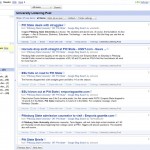The basic concept of the social web and Web 2.0 is one of conversations and user generated content. Engagement. Interaction. My focus today is on the former, with a dab of latter. Universities are much like other big brands, people talk about us in a lot of places, in a lot of ways, both good and bad. It is important that we pay attention to these conversations, not necessarily to jump in, moderate, or control them (don’t kid yourself, you couldn’t if you wanted to anyway), but rather so that we can get an idea of our reputation and see where we might need to make improvements. You can’t be everywhere, so you want to be able to go where your audience is, and you learn that by listening. And naturally we want to be able to share our successes as well. You can’t do any of that without paying attention. The challenge is that the web is a big dang place, and hearing when someone whispers your name can be a huge challenge. There are a number of tools that can help you do this.
Chris Brogan and Julien Smith talk about the process I’m sharing here briefly in their book Trust Agents. It is very sound advice (as well as an excellent book), and my intent is to simply expand on the concept brought up in the book. By seeing what and where people are discussing you, it allows you to determine what areas that you might not exist in adequately enough, and you might discover problems that you can fix that you may not have seen previously. The process is propped up by using Google Alerts tied to several queries and Google Reader (or your choice of RSS digestion). This process educates you, and as a result allows you to educate others. Sometimes others don’t realize how important something is until they see it coming out of someone else’s mouth. This is part of the problem that universities have a habit of hiring experts, but not expertise. Even though commenters and bloggers on the internet aren’t highly paid consultants, their voices will carry weight, especially if their views are critical.
 First thing’s first, identifying the best places to go hunt yourself out at. I’ll generally come up with a set queries I want to watch for, for instance “Pittsburg State University” and “Pitt State.” These are both common ways of referring to our college in the media, and generally “PSU” is too generic and tends to return results frequently from the *other* Pittsburgh (you know, the one with the evil goatee). Go take a spin by Technorati’s advanced search page and run exact phrase searches for each of the ways you want to watch for you school. Each result set will reward you with an RSS feed you can subscribe to. Copy those addresses down for later.
First thing’s first, identifying the best places to go hunt yourself out at. I’ll generally come up with a set queries I want to watch for, for instance “Pittsburg State University” and “Pitt State.” These are both common ways of referring to our college in the media, and generally “PSU” is too generic and tends to return results frequently from the *other* Pittsburgh (you know, the one with the evil goatee). Go take a spin by Technorati’s advanced search page and run exact phrase searches for each of the ways you want to watch for you school. Each result set will reward you with an RSS feed you can subscribe to. Copy those addresses down for later.
Next up I’ll make a swing past YouTube and do a similar search. YouTube is nice though, as like some other sites (like Twitter), they support a little logic in their search, so I can do a search for “Pittsburg State University” OR “Pitt State” all at once, which makes things much easier. You might notice though that the RSS feed provided by search results comes in by relevance rather than date. I use the method of https://www.youtube.com/rss/search/[YOUR_SEARCH_PHRASE].rss which will provide results based on date. You can still use the logic too. What I’ll normally do is run my previous query through something like a URL encoder to give me a URL safe string to stick into the path. In this case, my query that I put in becomes %22Pittsburg+State+University%22+OR+%22Pitt+State%22, which I can then stick into the RSS address just mentioned.
Marching on, Twitter is pretty straightforward. Just hit up https://search.twitter.com/ with your same (non-URL encoded) query you used for YouTube, and grab the result RSS feed that it throws your way. Lastly, go make the Google rounds: Blogsearch, and Alerts. By the time you’ve hit up each of these, you’re very likely to get some double coverage (especially if you do it right). That’s how you’ll know you’ve really cast a good, wide net, and you can start taking out sources that result in duplicates. Remember, you’d rather have to make the nets smaller than not have them big enough, otherwise you’ll possibly miss things and never know it. Theoretically, a comprehensive Google Alert will catch everything you find with Blogsearch and News, but I prefer to confirm that first, and then cut out what isn’t needed rather than assume that the comprehensive feed really will be.
 Now, to put a nice little bow on all this, you just need to manage the feeds. I’m going to go through bringing them into Google Reader, but you could just as easily use some other reader, like NetVibes, Thunderbird, or whatever you like, after all, it’s just a bunch of RSS. In Google Reader I create a new folder called “University Listening Post” to keep everything relevant in one area. Then I take all the feed links and add them to the subscriptions under that folder. Really hard, right? In the end, this is all just about finding a great combination of relevant RSS feeds, and putting them all in one place where you can easily follow them.
Now, to put a nice little bow on all this, you just need to manage the feeds. I’m going to go through bringing them into Google Reader, but you could just as easily use some other reader, like NetVibes, Thunderbird, or whatever you like, after all, it’s just a bunch of RSS. In Google Reader I create a new folder called “University Listening Post” to keep everything relevant in one area. Then I take all the feed links and add them to the subscriptions under that folder. Really hard, right? In the end, this is all just about finding a great combination of relevant RSS feeds, and putting them all in one place where you can easily follow them.
Oh, and we can’t forget the last most important thing. All of this doesn’t mean anything if you don’t do something with it. In many cases, this information is cool, but we have to make it actionable, and that process is going to be different for everybody. You could make this information available to different groups, or pass it on as needed. Do monthly or weekly digests for PR or Marketing. Direct student ambassadors to different locations to engage people. There are a lot of options if you can’t directly act on this information. Just remember, it’s about the conversation, and it’s not usually a conversation you start. Don’t try to control it, don’t try to take it over. It will be rare that the conversation takes place on your “territory,” so any attempt to deal with it heavy handedly is absolutely destined to backfire. That’s why I like the idea of getting students to go out and engage, it sort of lets you cheat a little and get positive messages out without it looking like the university itself (assuming you need to put positive spin on something). Just don’t forget to celebrate success too. It’s not all about damage control. If it is, well, I’d say you have much bigger problems to deal with.
So there you have it. Go set up your own listening post, and see what people are saying about your school. Find neat ways to engage those authors and communities. Try out other tools like Addict-o-matic for monitoring searches for your name and see if it reveals better results. If you have any other favorite tools or techniques, be sure to share them in the comments. We’d love to hear your success stories with sniffing out conversations on the web.
![]() photo credit: Richard Pluck
photo credit: Richard Pluck
Great post, and a simple and easy to use listening strategy which everyone should do. My issue is what you allude to at the end - what do you do with this information. I come across many points that are inherently institutionalized and require big changes in the way things are done. Many wont be changed, and that, to me, is the biggest issue. Great research falls short if big change doesn’t come with it.
The great thing about this though is that there is a low amount of effort going in that results in good output. With a handful of clicks, you can show just how much stuff is out there and isn’t being utilized, without any real burden to do it. If you have no channels to put it to use in, you now have leverage to show that channels need to be established. You can go to Dept X or Office Y and say “Look, see how many people are talking about you? They have problems with A or are starved for B. How can we make it easy for you to engage these folks?” With they data in hand, you can show the need from the very start.
Well said! I find Addictomatic to be a great listening post. I’ve learned about a lot of things going on at my college through it … which is not ideal but it’s something.
For us, this is a must for not only image management but also to find student generated content.
On thing I would add also is searches for unique landmarks on your campus. Do some searching first but if you know your campus is the only one with “XYZ Hall” it can get you some results event if they don’t mention your institution’s name.
Also the tool we have like a lot is a Yahoo Pipe called “Social Media Firehose” which does quite a bit of what you’re describing with some filters and makes it into and RSS feed.
https://pipes.yahoo.com/pipes/pipe.info?_id=f1ae63990f6d5b9e48ce807a77bb9995
Nice post Fienen. I wrote about this like a year and a half ago with much of what you said hereHow to Monitor your Online Identity. Of course that being a while ago it was definitely time for a revision.
Like I tell people all the time that think with social media they have to be engaged. Not so. If your website sucks then the last thing you want to do is spend your time in Social Media and not making your website better NOW! So with that I tell people to do the following with social media:
1. Listen
2. Come up with appropriate content creation ideas (because nothing on the web is brand new and someone has probably already written it up nice and you just need to relate it to your audience)
3. (and a very distant 3rd) Engagement
Ok call me an old person with old views but is a social website for schools really needed? where has the art of normal conversation and interaction gone.. is this why there are so many lonely people at university / colleges do we not need one 2 one communication any more? Or have I missed the point?
Great post, This is very good article because it is simple and easy to use listening strategy which everyone should do. I really satisfy with you…………..Well said!